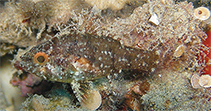Ajouter votre observation dans Fish Watcher
| Native range | All suitable habitat | Point map | Year 2050 |

|
| This map was computer-generated and has not yet been reviewed. |
| Foa fo AquaMaps Data sources: GBIF OBIS |
Envoyez vos Photos et vidéos
Pictures | Videos | Images GoogleFoa fo
Picture by Rose, J.-L.
Pictures | Videos | Images GoogleFoa fo
Picture by Rose, J.-L.
Classification / Names Noms communs | Synonymes | Catalog of Fishes(Genre, Espèce) | ITIS | CoL | WoRMS | Cloffa
> Kurtiformes (Nurseryfishes, cardinalfishes.) > Apogonidae (Cardinalfishes) > Apogoninae
More on authors: Jordan & Seale.
More on authors: Jordan & Seale.
Environment: milieu / climate zone / depth range / distribution range Écologie
Distribution Pays | Zones FAO | Écosystèmes | Occurrences | Point map | Introductions | Faunafri
Indo-Pacific: from East Africa and the Red Sea to French Polynesia; north to Japan and south to Australia.
Taille / Poids / Âge
Description synthétique Clés d'identification | Morphologie | Morphométrie
Épines dorsales (Total) : 9; Rayons mous dorsaux (Total) : 9; Épines anales: 2; Rayons mous anaux: 8; Vertèbres: 24. This species is distinguished by the following characters: usually 8-12 pored lateral-line scales and 13-15 gill rakers and rudiments; body scales margins uniform to pale edging; body mottled brownish with 5 darker irregular bars, the first anterior to origin of first dorsal fin, the second bar from posterior half of first dorsal fin through posterior half of pelvic fin, the third narrow bar between soft dorsal and soft anal fins, the fourth on caudal peduncle, and the fifth at base of caudal fin; axil of pectoral fin with a whitish spot; 3 whitish basicaudal spots partially in darkish basicaudal bar; whitish spot behind posterior base of soft dorsal fin; second dorsal fin, anal fin and caudal fin pale with darkish banding (Ref. 93673).
Nocturnal species; occurs inshore (Ref. 7300). Enters estuaries and quiet coastal bays, usually on mud or silty substrate with algae-rock outcrops or isolated soft corals (Ref. 48635). Solitary or in small groups (Ref 90102).
Life cycle and mating behavior Maturité | Reproduction | Frai | Œufs | Fécondité | Larves
Référence principale
Upload your references | Références | Coordinateur | Collaborateurs
Fraser, T.H. and J.E. Randall, 2011. Two new species of Foa (Apogonidae) from the Pacific Plate, with redescriptions of Foa brachygramma and Foa fo. Zootaxa 2988:1-27. (Ref. 93673)
Statut dans la liste rouge de l'IUCN (Ref. 130435: Version 2024-2)
Préoccupation mineure (LC) ; Date assessed: 14 February 2022
CITES
Not Evaluated
Menace pour l'homme
Harmless
Utilisations par l'homme
FAO - Publication: search | FishSource |
Plus d'informations
Trophic ecology
Éléments du régime alimentaire
Composition du régime alimentaire
Consommation alimentaire
Food rations
Prédateurs
Éléments du régime alimentaire
Composition du régime alimentaire
Consommation alimentaire
Food rations
Prédateurs
Ecology
Écologie
Écologie
Population dynamics
Paramètres de croissance
Max. ages / sizes
Length-weight rel.
Length-length rel.
Fréquences de longueurs
Mass conversion
Recrutement
Abondance
Paramètres de croissance
Max. ages / sizes
Length-weight rel.
Length-length rel.
Fréquences de longueurs
Mass conversion
Recrutement
Abondance
Life cycle
Reproduction
Maturité
Maturity/Gills rel.
Fécondité
Frai
Spawning aggregations
Œufs
Développement de l'œuf
Larves
Dynamique des populations larvaires
Reproduction
Maturité
Maturity/Gills rel.
Fécondité
Frai
Spawning aggregations
Œufs
Développement de l'œuf
Larves
Dynamique des populations larvaires
Anatomy
Surface branchiale
Brain
Otolith
Surface branchiale
Brain
Otolith
Physiology
Body composition
Nutrients
Consommation d'oxygène
Type de nage
Vitesse de nage
Visual pigments
Fish sound
Diseases & Parasites
Toxicity (LC50s)
Body composition
Nutrients
Consommation d'oxygène
Type de nage
Vitesse de nage
Visual pigments
Fish sound
Diseases & Parasites
Toxicity (LC50s)
Genetics
Génétique
Heterozygosity
Héritabilité
Génétique
Heterozygosity
Héritabilité
Human related
Aquaculture systems
Profils d'aquaculture
Souches
Ciguatera cases
Stamps, coins, misc.
Aquaculture systems
Profils d'aquaculture
Souches
Ciguatera cases
Stamps, coins, misc.
Outils
E-book | Guide de terrain | Clés d'identification | Générateur de fréquences de longueur | Outil de dynamique de population | Carte par point | Classification Tree
| Catch-MSY |
Articles particuliers
Télécharger en XML
Sources Internet
AFORO (otoliths) | Aquatic Commons | BHL | Cloffa | BOLDSystems | Websites from users | FishWatcher | CISTI | Catalog of Fishes: Genre, Espèce | DiscoverLife | ECOTOX | FAO - Publication: search | Faunafri | Fishipedia | Fishtrace | GenBank: génôme, nucléotide | GloBI | Google Books | Google Scholar | Google | IGFA World Record | MitoFish | Bases de données nationales | Otolith Atlas of Taiwan Fishes | PubMed | Reef Life Survey | Socotra Atlas | Arbre de Vie | Wikipedia: aller à, chercher | World Records Freshwater Fishing | Zoobank | Zoological Record
Estimates based on models
Preferred temperature (Ref. 123201): 24.2 - 29.2, mean 28 °C (based on 2296 cells).
Phylogenetic diversity index (Ref. 82804): PD50 = 0.5039 [Uniqueness, from 0.5 = low to 2.0 = high].
Bayesian length-weight: a=0.01445 (0.00680 - 0.03071), b=3.07 (2.89 - 3.25), in cm total length, based on LWR estimates for this (Sub)family-body shape (Ref. 93245).
Niveau trophique (Ref. 69278): 3.2 ±0.5 se; based on size and trophs of closest relatives
Résilience (Ref. 120179): Haut, temps minimum de doublement de population inférieur à 15 mois (Preliminary K or Fecundity.).
Fishing Vulnerability (Ref. 59153): Low vulnerability (10 of 100).
Nutrients (Ref. 124155): Calcium = 347 [134, 967] mg/100g; Iron = 1.91 [0.85, 4.38] mg/100g; Protein = 18.3 [16.6, 19.9] %; Omega3 = 0.15 [0.05, 0.49] g/100g; Selenium = 60.5 [16.7, 192.3] μg/100g; VitaminA = 40.1 [7.0, 242.5] μg/100g; Zinc = 3.52 [1.80, 6.38] mg/100g (wet weight);




